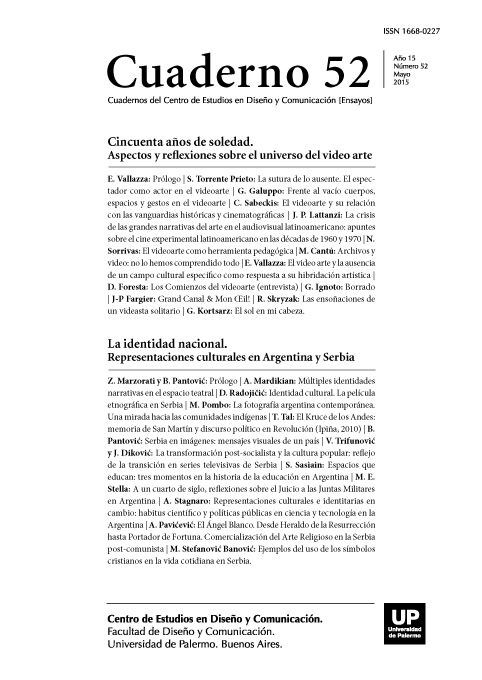El videoarte y su relación con las vanguardias históricas y cinematográficas
Abstract
In the early twentieth century, and following the First World War in Europe arise a group of innovative artistic movements that proposed to break the traditional
artistic forms. These manifestations, called artistic vanguards, put into crisis the rooted
values and posed a radical rejection of realist art and a taste for experimentation with new
forms of art. Following the example of other arts, the film vanguards, which emerge in
Europe in the 1920s, will question the dominant motion picture mode mainly imposed
by the Hollywood industry. Made up of artists from different fields: musicians, photographers, painters or writers, these vanguards looked for get experienced on the new media
breaking the systematized classical narration.
Four decades later, in the 60s, a group of artists linked to conceptual art, visual arts, musical arts and begin to use the new electronic imaging technology for artistic purposes
leading to Video Art.
Video art thrives well in the beginning of the main trends and manifestations of the latest
innovations, pop art, minimalism, Dadaism and Cubism. This new artistic movement
will postulate a critical position against art world conventions in coincidence with film
vanguard movements.
This article aims to analyze the characteristics of the film and video art vanguards, and
the cultural historical context where it took place, in order to establish the contact points
between the two events and the implications they had on the arts.
References
Alonso, R. (2005). Hacia una des definición del video arte. Publicado en ISEA Newsleter, # 100. Disponible en http://www.roalonso.net/es/videoarte/videoarte.php
Bonet, E. (1994). Cinema experimental. Universidad Pompeu Fabra. Disponible en:: http://www.iua.upf.edu/cinexp/cinexp.html
Bordwell, D. y Thompson, K. (1995). El arte cinematográfico. Barcelona: Editorial Paidós.
Burch, N. (1991). El Tragaluz del Infinito: Contribución a la Genealogía del Lenguaje Cinematográfico.
Madrid: Cátedra.
Epstein, J. (1926). Le cinématographe vu de l’Etna. Les Écrivains Reunís. París. Extraído de Alsina, Homero y Romaguera, Joaquim, (1989) Textos y Manifiestos del Cine, Madrid: Cátedra.
Gubern, R. (1989). Historia del cine. Barcelona: Editorial Lumen.
Maciunas, G. Disponible en: http://artecontempo.blogspot.com.ar/2005/06/tentativa-demanifiesto-fluxus-george.html
Marinetti, F. (1909). Manifiesto Futurista. Publicado en el Diario Le Figaro. París.
Paladino, D. (1995). La vanguardia francesa I, Impresionismo. en La Nación Revista, Cien Años de cine. Buenos Aires.
Bibliografía
Alberá, F. (2009). La vanguardia en el cine. Buenos Aires: Ediciones Manantial.
Alonso, R. (2005). Hacia una des definición del video arte. Publicado en ISEA Newsleter, # 100. Disponible en http://www.roalonso.net/es/videoarte/videoarte.php
Bonet, E. (1994). Cinema experimental. Universidad Pompeu Fabra. Disponible en: Bordwell, D. y Thompson, K. (1995). El arte cinematográfico. Barcelona: Editorial Paidós.
Gubern, R. (1989). Historia del cine. Barcelona: Editorial Lumen.
España C., Kriger C., Manetti R., Oubiña D., Paladino D., Valdez M. (1995). Suplemento Cien años de cine. Buenos Aires: La Nación Revista.
La Ferla, J. (comp). (1996). La revolución del video. Buenos Aires: Libros del Rojas.
Perez Ornia, J. R. (1991). El arte del video. Introducción a la historia del video experimental. Barcelona: RTVE y Ediciones del Serbal.
Roncallo, S. (2005). El video arte o el grado lego de la imagen. Signo y pensamiento, juliodiciembre, año/vol. XXIV, nro. 047, Pontifica Universidad Javeriana. Bogotá, Colombia.
Disponible en: http://redalyc.uaemex.mx/pdf/860/86004711.pdf
Zunzunegui, S. (1989). Pensar la imagen. Madrid: Cátedra.
(1987 marzo-mayo). Espacio del sentido y escritura narrativa en el vídeo de creación. Disponible en: http://www.cinefagos.net/index.php?option=com_content&view=article&id=914:essantos-zunzunegui&catid=30:documentos&Itemid=60
Los autores/as que publiquen en esta revista ceden los derechos de autor y de publicación a "Cuadernos del Centro de Estudios de Diseño y Comunicación", Aceptando el registro de su trabajo bajo una licencia de atribución de Creative Commons, que permite a terceros utilizar lo publicado siempre que de el crédito pertinente a los autores y a esta revista.


